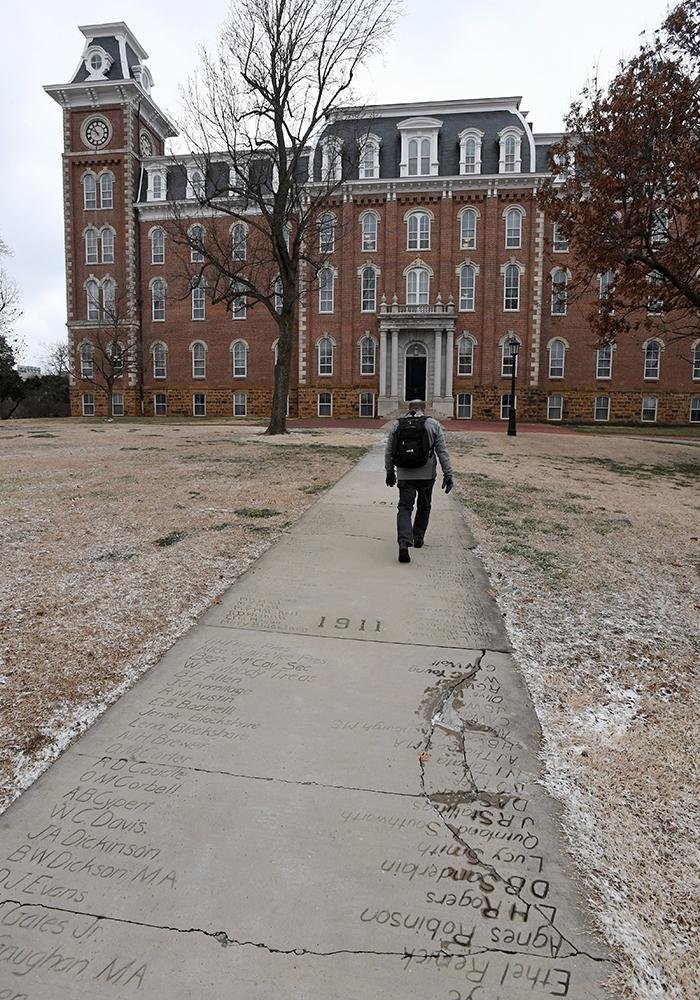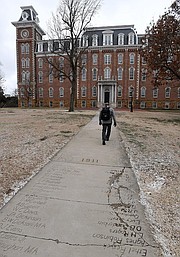FAYETTEVILLE -- Work is expected to begin this month to replace the oldest sections of Senior Walk at the University of Arkansas, Fayetteville, campus officials said.
Years of discussion involved different ideas for dealing with the crumbling portions of concrete sidewalk inscribed with the names of the school's first graduates.
Concrete will be used in replacing the first 50 years of the Senior Walk, which includes senior classes from 1875 through 1924, Mike Johnson, UA's associate vice chancellor for facilities management, said in an email.
Names will also be sandblasted -- the method used now for sections of Senior Walk commemorating recent graduates -- rather than trying to emulate the hand-inscribed work of students in the early 1900s, campus officials said.
"Our estimated completion date is the end of April," Johnson said.
The project cost is $502,460, Johnson said, with $250,000 in grant money from the Arkansas Natural and Cultural Resources Council helping pay for the work.
The grant application described granite panels replacing the sidewalk sections that extend a few dozen yards from the main entrance of the Old Main academic building. It described granite as "projected to last for over 150 years" and put the price tag at $676,990 for the Senior Walk replacement, an amount about 35% more than what the project is now costing.
Johnson said further talks led to the choice of concrete.
"In later discussions with the State Historic Preservation Office and ANCRC Staff, they felt strongly that keeping the Senior Walk materials in the standard concrete format with sandblasted names was most respectful to the historic nature of this special University heritage and in keeping within our core campus, federally-designated historic district," Johnson said. He said plans first developed by the university included options for either granite slabs or standard concrete.
UA's Senior Walk tradition began in the early 1900s.
For the senior classes from 1904 through 1924, student names were "hand chiseled into the freshly poured concrete walks," according to the grant application submitted last year.
In 1941, names of the university's earliest senior classes -- 1875 through 1903 -- were set into the concrete walk within a brick plaza area just outside the entrance to Old Main, the grant application stated.
"Our goal is to preserve significant portions of the existing walk for future public display," Johnson said.
No plan has been finalized, however, with the condition of the old Senior Walk sections to be a factor in any future display, Johnson said. One possibility is to place the old Senior Walk sections on display inside Old Main.
"We also plan to install some exterior signage along the section of the new Senior Walk to explain what was located here earlier," Johnson said, adding that the new signs will be a part of a larger "campus-wide signage effort" yet to be fully developed.
The Senior Walk sections for UA's earliest senior classes consist of a dozen or fewer names, but the tradition has endured even with the university growing to enroll more than 27,000 students this past fall. Graduates can still expect to see their names along with their classmates' on a section of Senior Walk.
In 2018, UA for the first time negotiated with private property owners to acquire rights to lay down Senior Walk sections. The Senior Walk sections for the class of 2018 are on the east side of Arkansas Avenue.
The university has a "master plan" for future Senior Walk locations commemorating graduating classes more than three decades into the future, though Johnson has said those site choices remain tentative.
Documenting the wear on the oldest Senior Walk sections began in 2013, according to UA's grant application, which refers to a "condition assessment" done in 2014. The grant application describes "an accelerating pace" of deterioration that has left "names illegible or completely missing."
Cracks appear in many of the sections, each of which is designated for a class year. The sidewalk sections for two classes, 1906 and 1907, were described in the grant application as "almost gone." The university previously replaced one panel, for the Class of 1905.
The Arkansas Natural and Cultural Resources Council initially awarded $150,000 for the project last year. Johnson said the increase is being offset by the lowering of another council grant to UA -- a $750,000 award for restoration of the school's Human Environmental Science building, now reduced to $650,000.
Mark Rushing, a UA spokesman, said the university's goal is to pay the rest of the Senior Walk bill -- $252,460 -- by raising private funds. Internal campus resources would be used otherwise.
After a "pre-construction" project meeting, UA officials expect the start date "to be not later" than Feb. 24, Daniel Clairmont, UA's director of engineering and construction, said in an email.
Names on the crumbling sections of Senior Walk include J. William Fulbright, a former U.S. senator and president of the university, who was a UA senior in 1924.
Stuart Fulbright, great-nephew of the former senator, told the Democrat-Gazette in 2015 that the cost for using granite -- at that time estimated by a UA official to be about $500,000 -- was "inappropriate."
On Thursday, Fulbright, a UA graduate and landscape architect, said in an email that he thought the university "did the right thing by choosing concrete," though he still expressed concern about costs.
"It'd be cool if they created a competition for the project and a reduced budget and put the rest of the money into something more progressive like scholarships or art on campus," Fulbright said.
Johnson said a designer and contractor have been chosen for the project.
The design team is being led by SCM Architects, which has offices in Fayetteville and Little Rock, and DCI, which also has offices in Fayetteville and Little Rock, Johnson said. The contractor is CDI Contractors, which has a corporate office in Little Rock.
The grant application also included plans to remove the brick plaza outside the main door to Old Main and replace it with sandstone atop a concrete base, putting the total cost of the improvements at $949,991.
Johnson said the plaza replacement is now considered a separate project. Rushing said the plaza project is moving forward, with the sandstone materials expected to arrive in May.
Metro on 02/07/2020

